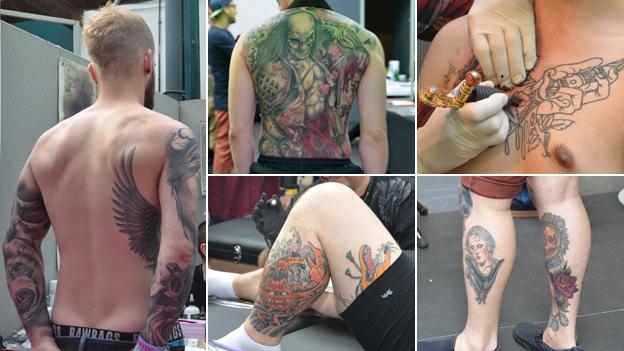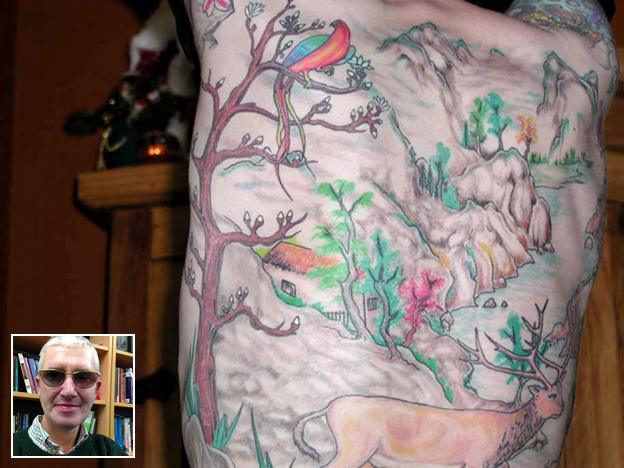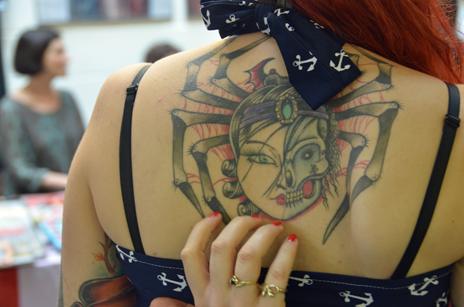Why do people go back for more and more tattoos?
- Published

Once a single tattoo was enough. Now a new breed of ink aficionados are returning again and again for multiple markings. What's behind the rise of the serial tattooee?
She started small, with the outline of a star on the back of her neck. Even her mum thought she was a wimp for not getting it coloured in.
But it gave Lauren Geisler an idea. Now a decade later, the 31-year-old has an ever-expanding William Morris pattern running from the top of her left arm, over her shoulder and across her back.
So far it has taken 15 hours over multiple visits, many of them painful, but it's still, Geisler says, a work in progress.
"There's no such thing as getting one tattoo," she tells friends when they make their inaugural trip to a parlour. "You're getting your first tattoo."
Tattoos are everywhere. Tattoos are respectable. Once associated with sailors, convicts and gang members, now one in five US adults, external say they have one.
But increasingly bearers are no longer content to settle for a single, discreet tattoo - like the prime minister's wife Samantha Cameron, who has a dolphin design on her ankle - that can be easily concealed.
Instead the inspiration is the likes of David Beckham, who has no fewer than 34 tattoos,, external and Cheryl Cole, whose collection includes a bunch of roses, external tattooed across her lower back, buttocks and legs.

A decade of ink: David Beckham's back in 2002 (left) and 2012
There aren't any reliable statistics about how many people have multiple tattoos. But last weekend's ninth annual London International Tattoo Convention was hailed by organisers as the biggest yet, suggesting the ranks of the most committed enthusiasts is growing.
Tattooists themselves say they've witnessed a marked increase in the numbers of customers coming back for a repeat needling.
"Look back to metal bands from the 1980s and they might have one or two tattoos between them - and these were the rock stars of the time," says Dan Gold, who has inked the likes of Kate Moss and Britney Spears and runs a studio in West Hampstead, London.
"Now, walk into any hairdresser's in London and you'll see at least one dude with neck tattoos and hand tattoos."
The trend inspired a Channel 4 series titled My Tattoo Addiction, , externalwhich focused on individuals covered with extensive and sometimes outlandish arrays of ink.

Lauren: "I'd already got one, where's the harm in more?"
But it's generally misleading to talk about the practice in terms of addicts and dependence, says Viren Swami, a University of Westminster psychologist who has conducted extensive studies of people with tattoos.
People typically take between two and seven years before getting their second tattoo, Swami says. If anything, he argues, people tend to consider their choices more carefully after their first because they have been made acutely aware at the point of a needle what it entails.
"It's actually quite infrequent that people make rash decisions about them," says Swami. "Pain is quite a big barrier. So is permanence and affordability."
Geisler, who works in architectural conservation, agrees. She took four years between her first tattoo and her second, deliberating over exactly what she wanted. Rather than feeling in thrall to an addiction or compulsion, on each subsequent session the experience gave her a sense of being in control.
"For me, it was a case of feeling like once I'd got started, I already knew the pain, what my body could stand," she says.
"I'd already got one, so where's the harm in more? Like you've crossed a threshold so there's nothing to stop you."

Stuart Ross (inset) has tattoos which conceal the effect of the condition vitiligo
The psychology of tattooing has been the subject of increased academic analysis in recent decades. But what drives people to come back for more, rather than settle for a single tattoo, is a question that researchers have largely neglected to address.
A 2012 study, external found that personality differences between tattooed and non-tattooed individuals were "generally small" although those with tattoos tended to be more extroverted and display a greater "need for uniqueness".
"It seems to be predominantly about the idea that you feel unique as an individual," says Swami. "People get tattoos for all sorts of reasons but that's the underlying one."
However, he says, there isn't any evidence that the character of multiple tattooees are different from those with a single emblem.
"There don't seem to be any persuasive traits that mark them out as different," says Swami. "They don't have different personalities. My feeling is that, at the end of the day, it's an aesthetic preference."
Sometimes there are other factors at play, too.
Stuart Ross, 48, suffers from vitiligo, which leaves much of his skin covered in white blotches. To conceal this, most of his upper body below the neckline - including the armpits - is covered with tattoos.

Following from his own experiences, Ross, a psychology lecturer at Newman University, Birmingham, has studied people's motivations for permanently adorning their bodies with ink. He believes those who undergo a lot of needlework do so because they find it satisfying.
"For those with lots of tattoos, I think it's all about the process, not the end outcome," he says.
"Even while it's painful, it's always controllable. That's why I think you see a lot of athletes with big tattoos - it's a kind of a rite of passage, like running a marathon."
Like much of what was once considered part of the counterculture, to some extent tattooing has been appropriated by the mainstream. The visibility of highly popular celebrities with multiple body markings like Beckham and Cole has no doubt contributed to the decision by many to adopt tattoos that would once have been considered outlandish or unsightly.
Still, those with brandings continue to face disapproval. A recent report by the British Sociological Association found that tattoos may be a hindrance to getting a job, external because of employers' prejudices. A 2007 study, external suggested that women with tattoos tended to be viewed as "less physically attractive, more sexually promiscuous and heavier drinkers".
Ultimately, there's no single, definitive reason why some people choose to get lots of tattoos and others don't. It may boil down to little more than personal taste.
Nonetheless, after 24 years in the trade, Gold says he knows instantly which first-time tattooees will return for more.
"I can tell when they walk in. It's the little devil in their eyes," he says. "I'll say to them: 'You'll come back,' and they always do."
You can follow the Magazine on Twitter, external and on Facebook, external